Indiana
| |
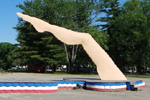 |
Roselawn |
Indiana |
USA |
Horizontal Dial |
Dial 971 |
| This dial consists of a fiberglass 18-foot high 36-foot gnomon in the shape of a bare tan-colored human leg. Hence the dial's name of "The Leg". The tip of the toe acts as a nodus. There are no hour lines and no declination lines. Instead, during summer months a series of hour markers are arranged on ground beneath the path of the nodus shadow. |
| |
| |
|
Roswell |
New Mexico |
USA |
Horizontal Dial |
Dial 490 |
| A beautiful bronze sundial sits on a pillar of rough marble. It was given to the Library by the Roswell Womens Club at the turn of the 20th century. Unfortunately the dial is damaged, but the Roswell Womans Club is searching for someone to repair the dial. |
| |
| |
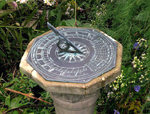 |
Round Lake Beach |
Illinois |
USA |
Horizontal Dial |
Dial 802 |
| This is an octagonal-shaped horizontal dial 240 mm (9.5 inches)across. The photo-etched plate has a central compass rose and delineated with a half hour circle and second circle dividing the time into quarter-hour increments. Roman numerals mark the hours from 6am to 6pm, with an extra hour mark to extend the dial's time-telling from 5am to 7pm. The dial is adjusted for the longitude of the site. Atop the dial face is a sturdy filigree gnomon approximately 5mm wide and 90mm (3.5 inches) high. South of the gnomon is a graphic Equation of Time. |
| |
| |
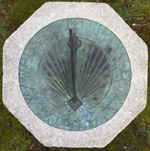 |
Saanich |
British Columbia |
Canada |
Horizontal Dial |
Dial 935 |
| The dial is simply but pleasingly decorated. The gnomon is plain. The pedestal is carved from stone taken from ruins of the Basilica of Ste. Anne de Beaupre in Quebec. The Quebec connection is indicated by the use of a Fleur De Lys on the dial face, and Napier's Scottish heritage is referenced by thistle motifs on brass accoutrements fitted to the pedestal. |
| |
| |
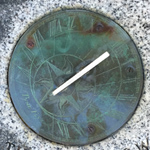 |
Saanichton |
British Columbia |
Canada |
Horizontal Dial |
Dial 936 |
| A simple horizontal bronze sundial about 9 inches in diameter. A sun occupies the interior of the dial with hour lines extending to a chapter ring with Roman numerals marking the hours. Each hour is divided into eight parts along the outer edge of the dial. The dial sits on a square plinth with corresponding square stepped base. |
| |
| |
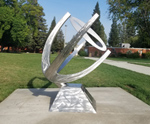 |
Sacramento |
California |
USA |
Equatorial Dial |
Dial 1024 |
| A 6 foot wide x 5-foot high burnished stainless steel equatorial sundial. The meridian arc is parabolic shaped and the equatorial arc is slightly more than a gracefully tapered half-circle 5 1/2-feet in diameter. The central elliptical gnomon plate, which swivels to face the sun, has an analemma cutout that casts an accurate civil-time shadow onto the equatorial ring below. The gnomon plate is laser-etched with the analemma, months and 365 days of the year, and marks for the equinoxes and solstices, and instructions. The equatorial timeline is laser-etched with hour and minute marks from 6:30 AM to 6:30 PM. The sundial body rotates and locks in position for either Daylight Saving or Standard Time. The sundial is highly accurate compensating for longitude (the equatorial ring is rotated 5min 24 sec early to measure solar time on the pacific meridian) and equation of time (by reading the east or west edge of the analemma plate gnomon shadow). The sundial often indicates clock time to within seconds and the date to within a portion of the day. A stainless steel base cover encloses the mounting hardware beneath. |
| |
| |
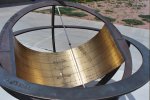 |
Sacramento Peak |
New Mexico |
USA |
Cylindrical Dial |
Dial 317 |
| The bronze cylindrical dial is 5-foot in diameter. The dial reads time and date from a rod gnomon cast onto an engraved, equatorial band. The dial shows date bands and solar time corrected for longitude (3 min 17s west of the 105 degree meridian). The dial is accurate to about one minute. At the noon hour line is an analemma showing the correction to mean time. The armillary sphere was designed and built by observatory staff members Dr. Don Neidig, Scott Gregory, and Mitchell Davis. |
| |
| |
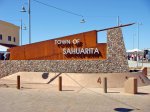 |
Sahuarita |
Arizona |
USA |
Obelisk or Vertical Gnomon |
Dial 623 |
| An unusual dial by John Carmichael using a gnomon tip to cast the shadow to indicate time. The dial face is poured concrete with inlaid metal longitude-corrected hour lines, and is nearly horizontal, inclining just 1.27 degrees for water drainage. It declines 89.28 degrees east of south. Bronze plaque has User Instructions and an Equation of Time Graph. Dial functions best during the middle part of the day. The style shadow lies outside of the dial face boundaries in the early mornings and late afternoons. The massive elaborate base that supports the gnomon rod is made from stacked flagstone. A waterfall cascades from the back south side of the base and flows a long distance to the south through a canal that has several water fountains and pools along the way. Around the base is a planter with bedding plants. The base and gnomon are lighted at night. |
| |
| |
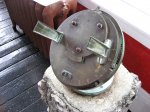 |
Saint Anthony |
Newfoundland |
Canada |
Heliochronometer |
Dial 169 |
| A Pilkington & Gibbs Heliochronometer, 9 in. diameter, 9 in. high bronze with two sights, 3 x 1.5 in. Points of compass on dial base, months and dates on face. Rotates to compensate for EOT. Dial is a circular plate, mounted to allow adjustment for latitude. Gnomon consists of two cast posts with vertical slits, about 6 in. high, on opposite sides of plate. Another adjustable scale permits EOT corrections. It was part of original house from 1909-1939. Not dated, but the chronometers were sold between 1907-1914. Now on display in museum and not set up for use. Heavily patinated with some corrosion. Fabricated by Pilkington & Gibbs Ltd, Preston England, # 433. The dial is mounted to a solid Labradorite pillar, 1 foot square, 21 inch high. |
| |
| |
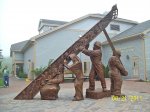 |
Saint John |
New Brunswick |
Canada |
Horizontal Dial |
Dial 743 |
| A large horizontal dial whose cast metal gnomon is a sculpture commemorating the Canadian National Day of Mourning. The gnomon is supported by statues representing toiling laborers. The surrounding brick courtyard includes bricks marked with Roman hour numerals.
The dial sculpture is identified as the Day of Mourning Monument and was dedicated on the Canadian National Day of Mourning, April 28, honoring those workers in Canada who have been killed, injured or disabled on the job. |
| |
| |
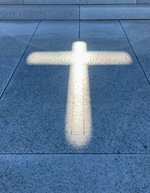 |
Saint Louis |
Missouri |
USA |
Sun Alignment |
Dial 1042 |
| The sundial, or more properly an alignment gap in the shape of a cross, is cut into the south wall of the Cascade Mausoleum. The cross shaped gap was cut into a 32,000-pound block of granite located at the top of the second flight of stairs, carefully angled at 27.9 degrees through this two-foot-thick block. Every year, on Dec 20th at 11:58 am, the sun shines through the cut and projects a cross 4x 8 feet in size on the granite floor located at the bottom of the stairs. The cross illuminates the floor for about 4 minutes, only aligning on Dec 20th at solar noon. |
| |
| |
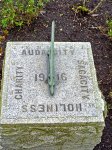 |
Salem |
Oregon |
USA |
Horizontal Dial |
Dial 708 |
| A 14 inch square California granite horizontal dial with a bronze gnomon with hour and half-hour marks and Roman numerals showing PST. Dial face is engraved with the Class Year 1916 and the motto Audacity, Sagacity, Holiness and Charity. The gnomon may have been replaced since originally installed. The dial is atop a gray granite pedestal integral to the dial itself.
The June 8, 1916 Collegian university newspaper provided this: "In presenting the sundial to the university, Walter Gleiser, president of the class, gave a forceful speech in which he portrayed the never-failing accuracy of the instrument's function, believing that it would be of use to the community, and that it should symbolize the good that students of Willamette should be to the world." |
| |
| |
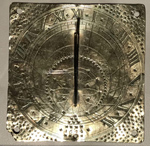 |
Salem |
Massachusetts |
USA |
Horizontal Dial |
Dial 124 |
| Here is a bronze dial approximate 8 inches in diameter with the date 1644. In spite of its age, it is now highly polished showing little if any wear to lines, engraving, and mounting holes. Roman hour numbers go from 5am to 7pm and the chapter ring is divided into quarter hours. The dial face is square and outside the hour ring are many small 5-point stars, stamped with a tool. The dial looks different from those made in London and the Proctor family immigrated to the New World in1635. Measuring the hour lines, the dial was probably made for Salem at 42.5 deg latitude. However an analysis of the hour lines shows the best fit latitude is 44.5 deg. The dial was presented to the Peabody Museum in 1907 by Abel Proctor and is attributed to John Proctor, who along with his wife Elizabeth, were accused of witchcraft in 1692. At the time Proctor was a wealthy tavern owner, but nevertheless was hanged. His wife was spared due to the fact she was pregnant, but remained "convicted" through out her life. |
| |
| |
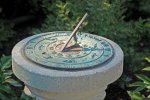 |
Salem |
Massachusetts |
USA |
Horizontal Dial |
Dial 131 |
| Approx. 10 inch diameter cast bronze horizontal dial. Inner ring has zodiac signs, middle ring has cherubs, leaves and a crown, and outer ring has hours 4AM-8PM in Roman numerals but no hour lines. The 6AM and 6PM lines are opposite each other but their hour lines do not pass through the root of the gnomon. It is believed the dial was installed about 1910 by then owner Caroline Emmerton. The dial was moved in 2007 to a less sunny location to make room for a seaman's memorial sculpture. The dial pedestal is traditionally decorated stone with circular top |
| |
| |
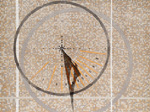 |
Salem |
Oregon |
USA |
Vertical Dial |
Dial 1103 |
| This vertical declining sundial is form with small squares of tile, showing the hours within a dark grey circle of tiles. The hours are marked by long orange-tile hour lines while the half-hours are marked by two dark grey tiles. A secondary circle of light grey adorns the wall, showing the length of the shadows and making the dial aesthetically pleasing. The background tiles are porcelain in common designer colors. The gnomon is a substantial stainless steel shape formed with a hole and curving points on the downward side, allowing leaves and small branches to slide off. |
| |
| |
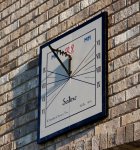 |
Saline |
Michigan |
USA |
Vertical Dial |
Dial 631 |
| A north-facing vertical dial of wood approximately 30 inches square with steel gnomon. Gnomon support includes "M M" representing 2000 millennium. Dial face includes script "RJ" for owner's initials as well as additional "M M" symbology. Hour markings show Eastern Standard Summer Time. Dial is displayed during summer months only, during which time it can be seen from the street.
Dial is on private property but can seen from a public street. |
| |
| |
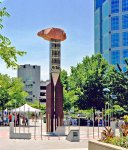 |
Salt Lake City |
Utah |
USA |
Obelisk or Vertical Gnomon |
Dial 347 |
| A 24 foot tall azimuth dial in a complex sculpture comprising a light projection gnomon within a 36 foot diameter base with numerous additional shadow-casting structures. The "Asteroid Landed Softly" sundial sculpture was created in 1993 by architect Kazuo Matsubayashi. The sculpture symbolizes the concepts of space and time: space as a large boulder (asteroid) sitting on a square pedestal; and, time as an azimuth sundial that shows the path of the sun through the day and seasons. |
| |
| |
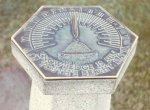 |
Salt Lake City |
Utah |
USA |
Horizontal Dial |
Dial 114 |
| Horizontal brass dial with a hexagonal shape, about 8 inches on a side. .Unusually small gnomon, only about 4 inches high. A beehive in relief is pictured at the base of the gnomon, perhaps explaining the hexagonal dial shape. Roman numerals with hour and quarter hour lines. Dial sits on a hexagonal pillar. |
| |
| |
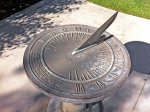 |
San Bernardino |
California |
USA |
Horizontal Dial |
Dial 188 |
| A 23 inch diameter horizontal bronze dial with 12 inch high gnomon and with hour, half-hour and quarter-hour lines from 5:30 AM to 7:30 PM and Roman hour numerals from 5 AM to 7 PM. Dial sits atop a 27 inch diameter stone pedestal 37.5 inch high. |
| |
| |
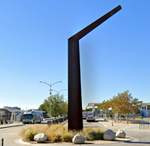 |
San Bernardino |
California |
USA |
Horizontal Dial |
Dial 1041 |
| This is a monumental horizontal sundial that from the ground simply looks like a giant pole with a slanting beam. High above the ground that beam is actually a segment of a gnomon, casting its shadow on the concrete plaza below. Then, if the eye is discerning, the concrete alternates in light gray and darker gray motif for the hour sections. From space (or Google Earth) the layout of the hour angles is clearly visible, radiating from a point considerably south of the gnomon pole, showing the hours from 9AM to 3PM local solar time. Hour line plaques extend from 10AM to 7PM. |
| |
| |
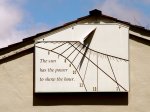 |
San Carlos |
California |
USA |
Vertical Dial |
Dial 424 |
| This vertical dial is approximately 4 foot high by 6 foot long, mounted on the end wall of a house that can be publicly viewed. Dial has hour lines and lines marking the equator and solstice shadow limits. Made of wood and brass. |
| |
| |
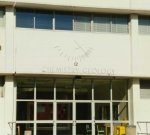 |
San Diego |
California |
USA |
Vertical Dial |
Dial 19 |
| Above the southwest entrance of the Chemistry-Geology Building is a vertical declining dial built by Richard L. Threet in 1979. The dial uses thin aluminum tubing as a gnomon to cast shadows on a ring of hour and half hour lines approximately 9 feet in diameter. The lines were originally painted black on the white concrete wall with only the 9 am, 12 noon, 3 pm and 6 pm lines boldly numbered. Since then the dial has lost all but the 12. |
| |
| |
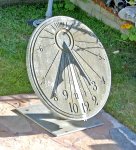 |
San Diego |
California |
USA |
Vertical Dial |
Dial 80 |
| This dial was originally owned and installed at Sea World in San Diego but was sold and purchased by Verlyn Kuhlmann. A 39 inch diameter reclining vertical dial of cast concrete with a 20 inch long steel gnomon. Dial reclines about 50°. Includes cast hour lines with Arabic numerals and longitude correction. A separate plaque provides instructions and an EOT graph. The dial is mounted on a 24 inch square aluminum base plate and short column support. |
| |
| |
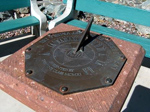 |
San Diego |
California |
USA |
Horizontal Dial |
Dial 213 |
| This is not the Koester dial at SDSU, but a far more interesting horizontal dial originally dedicated to the San Diego Normal School for elementary teaching by the class of June, 1911. The 18-inch octagonal bronze dial was originally designed by San Diego Clock maker Joseph Jessop and mounted on a miniature Doric column. The dial was placed within the circular lawn directly in front of the school's main entrance at the intersection of Park and El Cajon Boulevards. |
| |
| |
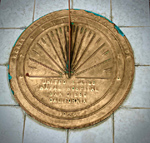 |
San Diego |
California |
USA |
Horizontal Dial |
Dial 1079 |
| Farenholt sundial for U.S. Naval Hospital San Diego California. This cast bronze dial was designed and commissioned by RADM Farenholt for U.S. Naval Hospitals at bases where he was commanding officer, visited, or had special meaning to him. The dial is 18 inches (46cm) in diameter. The outer chapter ring has the motto, followed by a chapter ring with Arabic hours 6am to 6pm, raised hour lines that radiate from near the foot of the gnomon and short half-hour lines. The gnomon has graceful curves original had a trefoil cut-out in the center. The restored gnomon has an irregular cut-out based on a photo of the original gnomon's shadow. Below the gnomon is the naval command name, followed by the commissioning date in the southern portion of the hours chapter ring. Dial has been restored, now having a gold luster. |
| |
| |
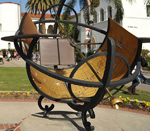 |
San Diego |
California |
USA |
Equatorial Dial |
Dial 815 |
| This broad band equatorial dial was dedicated in 1978 to George A. Koester, former Executive Dean of San Diego State University. The approximately 3-foot dial is on a brick pedestal situated on on a small dais. Concentric brick circles complete the large dial plaza. |
| |
| |
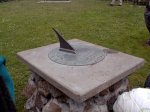 |
San Francisco |
California |
USA |
Horizontal Dial |
Dial 417 |
| A plain but nicely done brass horizontal dial about 2 feet in diameter mounted on a simple concrete pedestal. The dial is in good condition, but about 50 degrees out of alignment. |
| |
| |
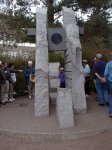 |
San Francisco |
California |
USA |
Sun Alignment |
Dial 418 |
| This is a 16 ton granite statue by Richard O'Hanlon entitled "Sunstone I" and was designed in collaboration with astronomer David Cudaback. A small wall of rock with a round inlay of dark stone is supported high upon two tall vertical slabs of granite. At the back is a "heel stone" with marks to show where the sunlight strikes at the Equinox and Solstice. |
| |
| |
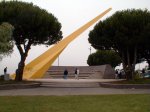 |
San Francisco |
California |
USA |
Horizontal Dial |
Dial 419 |
| Hilltop Park was built by the San Francisco Redevelopment Agency in 1987. The Landscape Architect was Michael Painter and Associates. Here is a giant sundial 70 feet in diameter with a bright yellow painted steel gnomon 78 feet long. The dial has a cement base and was designed to be used as the stage for a surrounding amphitheater. Dial shows wear and abuse, with graffiti covering the lower portion of the gnomon. Still, it is awe inspiring. |
| |
| |
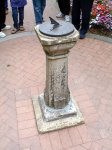 |
San Francisco |
California |
USA |
Horizontal Dial |
Dial 420 |
| A small 10-inch cast iron dial from England honors Shakespeare in a garden of the same name. The dial is on a small pedestal in the middle of the courtyard walkway and surrounded by trees. Lovely, but many shadows pass over the dial during the day. The dial plate was made for latitude 54 degrees. The gnomon appears to have been cut down to accommodate the 38 degrees for San Francisco. This "hack" method of correcting a sundial does not give correct time. |
| |
| |
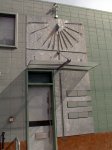 |
San Francisco |
California |
USA |
Vertical Dial |
Dial 421 |
| Dial is on an outside wall above the entrance to a private residence. The dial was designed by Stan Musilek. The dial back is made out of galvanized steel. Metal rails indicate the hours. Instead of Arabic or Roman numerals, the proper number of steel balls indicate the time of each hour. Overall, the dial is 4 by 6 feet. |
| |
| |
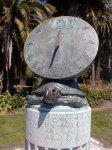 |
San Francisco |
California |
USA |
Vertical Dial |
Dial 20 |
| Known as the "Navigators' Dial", this sundial is dedicated to three early explorers of the California coast. The dial itself is a sliced bronze globe of the earth sitting on the back of a tortoise. Overall, the globe hemisphere is about 2 1/2 feet in diameter, showing the world in relief centered on California. The flat face of the hemisphere is a beautiful vertical reclining dial. The dial sits atop a cylindrical stone column. |
| |
| |
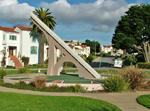 |
San Francisco |
California |
USA |
Horizontal Dial |
Dial 82 |
| Built in 1913 as a promotion for a housing development that was once a racetrack, this dial boasted (incorrectly) that at 34 feet in diameter and a gnomon style 28 feet in length, it was the largest known dial in the western world. Nevertheless it gathered much publicity and newspaper articles thanks to the Urban Realty Improvement Co. The company put out a brochure "The Sundial at Ingleside Terrace with Comments on Homes" using the sundial as a lure to attract home buyers to the newly constructed residential neighborhood. On Oct 10, the same day the Panama Canal was opened, a festive gala was held at the sundial dedication attended by more than 1500 people. Photos show young girls dancing around a small pool that surrounded the gnomon. A light (visible in several early photos) dangled from the tip of the gnomon. Bronze statues of seals were originally in the pool, but by 1920 the pool was filled with concrete and the seals were gone. Today the pool area is painted green. |
| |
| |
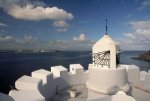 |
San Juan |
Puerto Rico |
USA |
Vertical Dial |
Dial 349 |
| A round pillar supports a rock cube with vertical dials on all four faces. This is one of the oldest in the Americas, erected by the Spanish around 1645 during the rule of Fernando de la Riva y Aguero. The vertical dial cube was crowned with a weather vane on top. This sundial was the first to be installed in the Antilles and was probably the second sundial to be placed in the New World. |
| |
| |
 |
San Ramon |
California |
USA |
Equatorial Dial |
Dial 726 |
| This 5 x 5 x 6.5 foot stainless steel bow-string equatorial sundial is a precise heliochronometer with internal cam mechanism to correct for the Equation of Time. This exceptional dial is made of welded stainless steel sheet and weighs 330 pounds according to the designer Lee Palmer Stephenson. The dial face of the 60 inch diameter equatorial ring is marked with hour, half-hour, 15 minute, 5 minute and one minute lines and Arabic hour numerals showing PST and PDT. |
| |
| |
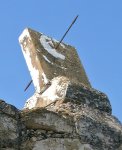 |
San Ygnacio |
Texas |
USA |
Equatorial Dial |
Dial 571 |
| A stone equatorial dial with an iron gnomon. Inscribed on both sides with hour lines. Placed above an entrance to a walled fort also built in 1851. Legend says Jose Villarreal designed and built the dial to celebrate his escape in 1820 as a child after capture by Lipan Apache Indians and being guided by the north star in his return home. Dial Recorder Mary Garza is the great-great-granddaughter of Jose Villarreal. |
| |
| |
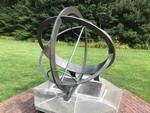 |
Sandwich |
Massachusetts |
USA |
Armillary Sphere |
Dial 175 |
| Bronze armillary dial about 40 inches in diameter, weighing between 1100-1200 pounds. The dial has wide 4 inch meridian and equatorial rings. The equatorial ring is flanked with small arctic and antarctic circles near the poles. The gnomon is a brass rod 1 inch in diameter. According to Heritage Museum, "Originally the sundial was highly polished and the engravings on the dial and the instruction plaques were all filled with red paint to make it easier to read. The piece has acquired a patina now and traces of the red paint are still visible." The dial is corrected for longitude and along one side of the octagonal stone pedestal is a graph of the equation of time with instructions on how to read corrected time from the dial. |
| |
| |
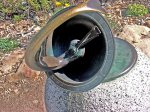 |
Santa Barbara |
California |
USA |
Equatorial Dial |
Dial 232 |
| A small bronze equatorial dial made by Victor E. Edwards in the 1920's. It has an unusual crescent shaped arm with notch at the upper end. The arm is rotated until sunlight through the notch strikes an analemma on the lower inner curve of the crescent. Time is then read on a circular dial from an "hour hand" pointer extending from the base of the crescent. The dial is mounted on a granite pedestal with spherical top 21 inch high. |
| |
| |
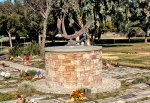 |
Santa Clara |
California |
USA |
Equatorial Dial |
Dial 774 |
| A 5 foot 9 inch wide cast bronze ring equatorial dial on a low brick mortared pedestal. The full semicircular hour ring has hour, half-hour, fifteen minute and 5 minute marks, and Roman hour numerals. The dial is lightly patinated and has a central gnomon rod with arrowhead. |
| |
| |
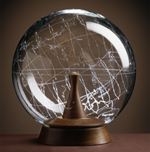 |
Santa Cruz |
California |
USA |
Globe or Hemispheric |
Dial 824 |
| This is a globe dial with a twist: a glass sphere is used to represent the earth with continent lines scribed on the globe along with hour lines, analemma figure for each hour, tropic of cancer, tropic of capricorn, equator, and a line representing the local horizon. The globe is etched with the dial site at the globe's zenith. The dial has a central gnomon. When the shadow of a pointer falls on the gnomon the time is read using the correct side of the hour line analemma. |
| |
| |
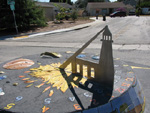 |
Santa Cruz |
California |
USA |
Horizontal Dial |
Dial 1044 |
| This is a colorful dial raised on a dais so that traffic doesn't hit it. Called "Light Time", the center of the dial has an artful yellow-orange impression of a sun surrounded by planets, moons and even a comet. Hours are marked in two colors for standard and savings time. The gnomon is 3/8 inch steel in the silhouette of a light house beneath the style line acting as a beam of light. |
| |
| |
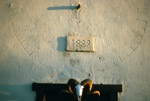 |
Santa Cruz Island |
California |
USA |
Vertical Dial |
Dial 899 |
| This vertical dial has undergone a number of restorations since it was set in lime in 1889. A photograph from 1900 shows the placement of a gnomon rod is horizontal. In 1992 before the National Park Service restoration in 2012 the gnomon is set in a polar orientation. But it doesn't really matter since the hour lines are marked at nearly regular 15 degree intervals with half hour sub-marks. |
| |
| |
 |
Santa Rosa |
California |
USA |
Horizontal Dial |
Dial 476 |
| This bronze horizontal dial is about 14in (356cm) in diameter with simple hour lines radiating from the gnomon foot to the circumference where Roman hour numbers mark the hours from 5am to 7pm The dial stands in the middle of a bronze lotus flower about 80in (2m) in the round. |
| |
| |
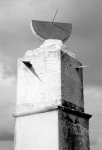 |
Santo Domingo |
|
Dominican Republic |
Pillar Dial |
Dial 348 |
| At the upper end of a tapering pillar is a rock cube with vertical dials on two faces. The dial was erected during the administration of Francisco Rubio y Pernaranda around 1753 in front of the Governor's Palace and was used during the centuries of Spanish rule as the official marker of time. An equatorial dial was placed on top of the cube probably around 1787 and was later broken off by a hurricane. In 1992, as part of the Fifth Centennial Discovery activities, the equatorial dial was reinstalled on top. Dial sits atop a mortar or rock block. |
| |
| |
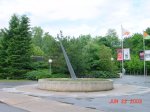 |
Saratoga Springs |
New York |
USA |
Horizontal Dial |
Dial 304 |
| A horizontal dial 43 feet in diameter, built on a raised circle flower bed raised about 3 feet above the ground. Outside the raised circle the hours are shown by roman numbers are embedded in the walkway. The metal gnomon is approximately 20 feet above ground and is centered in the raised flower bed. |
| |
| |
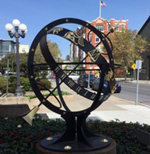 |
Saratoga Springs |
New York |
USA |
Armillary Sphere |
Dial 951 |
| Beautiful iron armillary sundial about 6 feet high. Painted black it has gold Roman numeral hours on the equatorial time band. On the outside of the equatorial band are the twelve zodiac motifs and stars are on the meridian band. The gnomon deviates from the classic arrow, having a gold flange at the base and a spiked orb at the north end. |
| |
| |
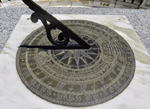 |
Saratoga Springs |
New York |
USA |
Horizontal Dial |
Dial 954 |
| The beautifully engraved horizontal dial plate is a reproduction of the original 1901 dial. It is inscribed with “Lat 43 degrees 5 N, Long. 73 degrees 46.40 W.” This is at slight variance from the current GPS position, implying that the dial has been moved from its original position. The dial plate is 18 inches in diameter and the gnomon has a vertical height of 8.5 inches. The gnomon and dial plate are aligned at 12 degrees west of true north. Significantly, the compass magnetic declination for this location is 13.5 degrees west of true north. This misalignment makes the dial about 30 minutes fast. This is particularly unfortunate since the inscribed dial is capable of showing time to the nearest minute. The stone table upon which the sundial rests is a reproduction of a table found in the ruins of Pompeii. |
| |
| |
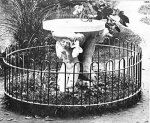 |
Saratoga Springs |
New York |
USA |
Horizontal Dial |
Dial 532 |
| A marble horizontal dial on marble sculpture pedestal. The original bronze Treble Cleft gnomon is now missing. |
| |
| |
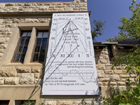 |
Saskatoon |
Saskatchewan |
Canada |
Vertical Dial |
Dial 980 |
| It is a replacement for a south-facing vertical dial that was in the same location until the 1990s. It is approximately 4-foot wide by 12 -foot long. The gnomon is a metal rod held by four struts. The dial tells local solar time, showing Roman hours from 6am to 6pm. There is an elaborate Equation of Time graph and instructions for use at the bottom of the dial. At the top is latitude, longitude and elevation. |
| |
| |
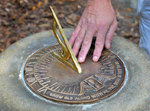 |
Savannah |
Georgia |
USA |
Horizontal Dial |
Dial 942 |
| An 8-inch diameter bronze dial, with the traditional hourglass and wings says "Grow old along with me, the Best is yet to Be", The chapter ring has Roman numerals with hour marks delineated every 15 minutes. The dial sits upon a concrete pillar inscribed to Louis Burke Toomer. |
| |